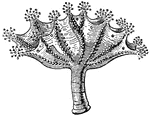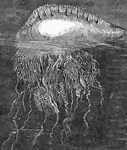The Jellyfish ClipArt gallery includes 82 line drawings of the phylum cnidaria, Jellyfish are free-swimming creatures that are also called medusa.
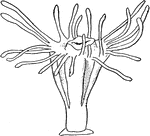
Scyphozoan Jellyfish
Jellyfish have several different morphologies that represent several different cnidarian classes including…

Scyphozoan Jellyfish
Jellyfish have several different morphologies that represent several different cnidarian classes including…

Scyphozoan Jellyfish
Jellyfish have several different morphologies that represent several different cnidarian classes including…

Pelagia labiche
"With four foliaceous arms, and long filaments depending from the rim of th umbrella, also found in…

Laomedea
"Stages in the development of Laomedea; A-F stages in segmentation; G, the planula enclosed in the maternal…
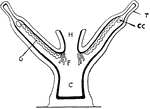
Lucernaria
"Diagram of Lucernaria. C., Cavity of gut (colenteron); F., gastric filaments; H. hypostome; G., gonad;…

Portuguese Man-of-War
The Portugures man-of-war has a bladderlike float, and locomotion depends upon the wind and current.…

Fleet of Medusa
"They usually inhabit the deep seas. They are rarely solitary, but seem to wander about in considerable…
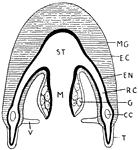
Medusoid Structure
"Structure of a Medusoid. ST., Stomach; M., manubrium; V., velum; T., tentacle; C.C., circumference…

Favonia octonema
"With a nearly hemispherical body, showing a long proboscis, at the root of which are eight branchiferous…

Physalia
"Physalia has no proper mouth, but the food is conveyed to the digestive cavity through a number of…

Freshwater Polyp
"Fresh-water polype (hydra), two specimens, the one expanded the other contracted, showing multiplication…

Porpita Pacifica
"The Porpitae consist of colonies of floating animals furnished with a cartilaginous, horizontal…
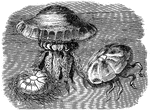
Rhyzostoma Cuvierii
"These fragile creatures are able to make long voyages on the surface of the sea. Their nature is such…

Sense of Sight
In animals there are different types of sight. Some have what we call simple eyes. The simplest eyes…
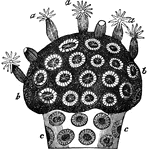
Astrae virdis
"a a, expanded polypes; b b, polypes withdrawn into their cells; c c, coral uncovered by flesh, showing…

Portuguese Man of War
There is a large oblong crested float which buoys the fish up, from which hang many tenticles, which…
